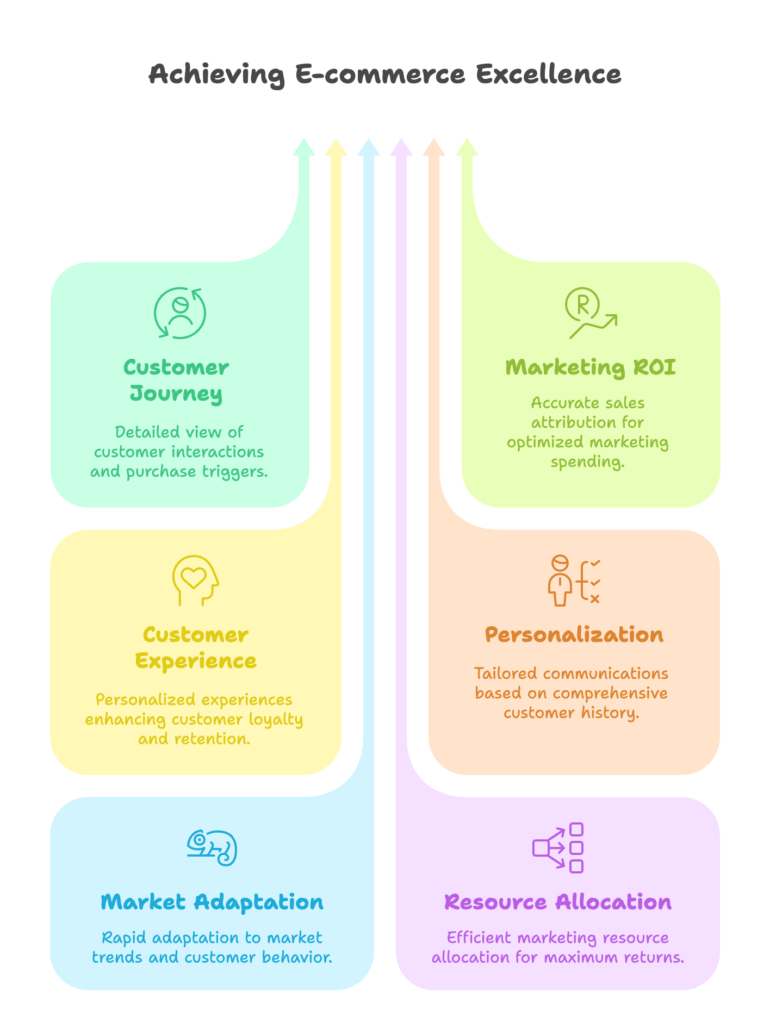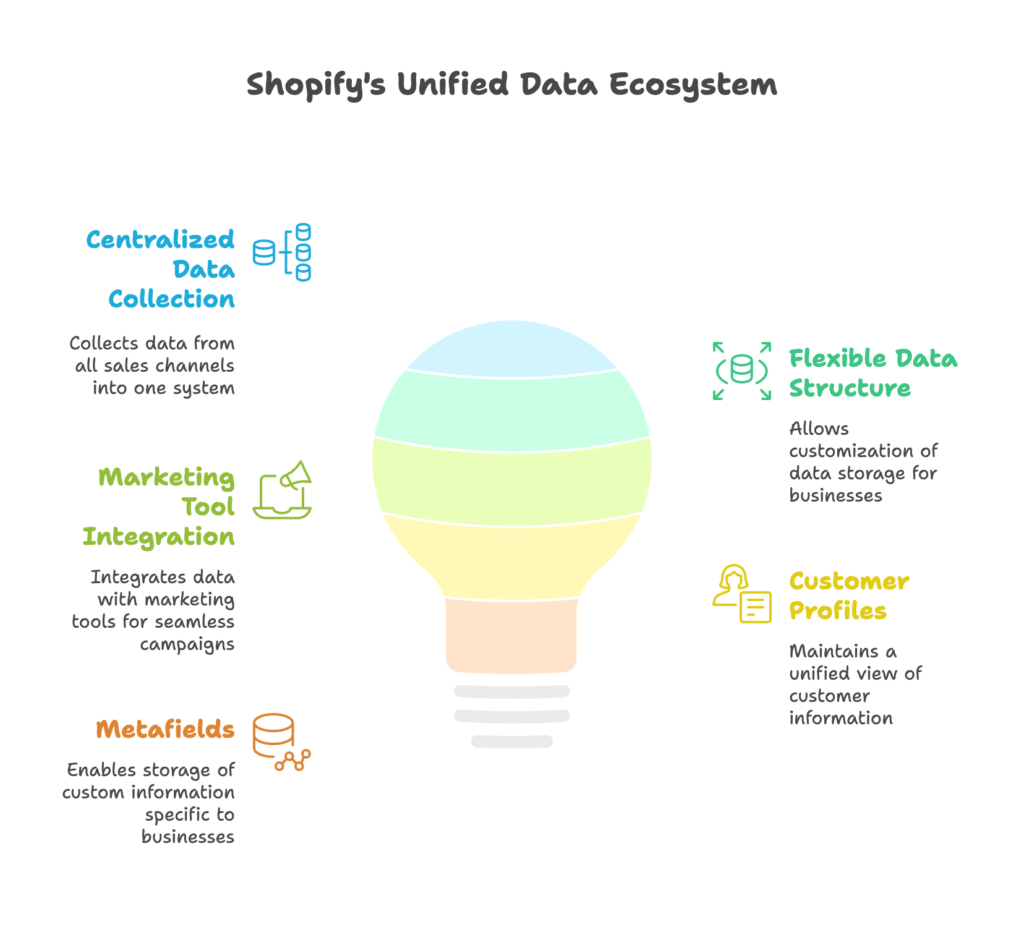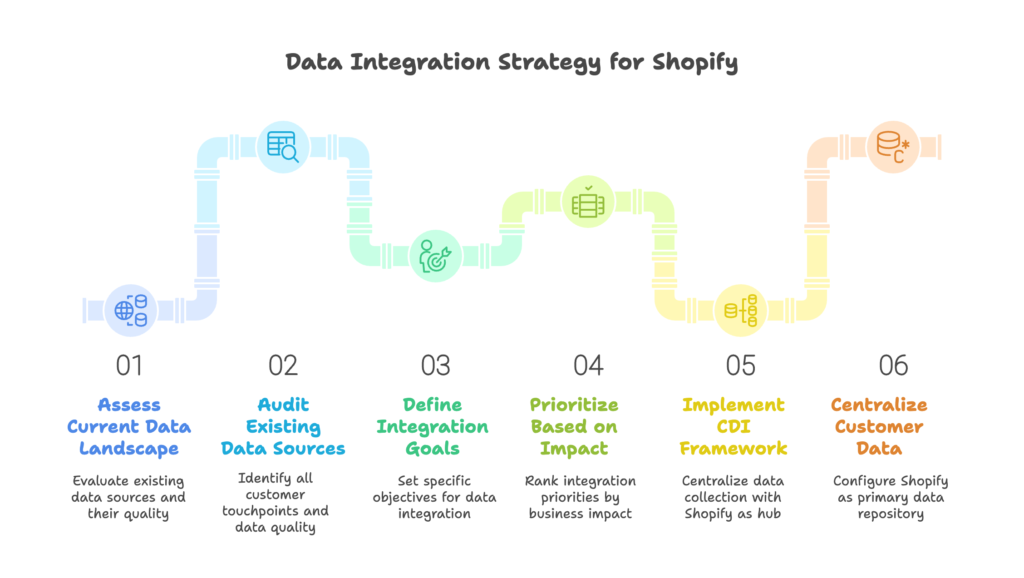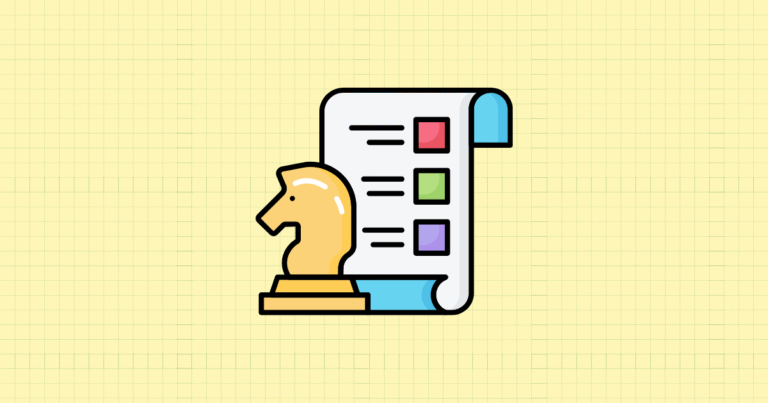Ever feel like you’re trying to complete a jigsaw puzzle with half the pieces missing? That’s exactly what running marketing campaigns feels like when your customer data is scattered across a dozen different platforms. In today’s multi-channel world, your customers are leaving digital footprints everywhere—your Shopify store, Instagram, email, TikTok, physical locations—yet most businesses only see fragments of the whole picture.
This fragmentation isn’t just an organizational headache. It’s bleeding money from your marketing budget and creating disjointed experiences that frustrate your customers. One recent study showed that businesses with unified customer data improve marketing ROI by up to 30% compared to those with fragmented systems.
But here’s the good news: Shopify has evolved into a powerful hub for unifying your marketing channel data. With the right approach, you can transform disconnected data points into a comprehensive view of your customer journey, allowing for the kind of personalized marketing that drives loyalty and sales.
In this guide, we’ll walk through exactly how to create this unified view—from understanding Shopify’s data architecture to implementing advanced integration strategies and future-proofing your approach against coming privacy changes. By the end, you’ll have a clear roadmap for bringing all your marketing channel data together in Shopify to create more effective, efficient campaigns that speak directly to your customers’ needs.
The Challenge of Fragmented Customer Data
Picture this: Sarah discovers your brand through an Instagram ad, browses your site on her phone during lunch, abandons her cart, opens your promotional email that evening, and finally completes her purchase through your mobile app two days later. How do you track this journey? For most Shopify store owners, this scenario creates four or five separate data points across different platforms—with no easy way to connect them.
The Multi-Channel Reality of Modern E-commerce
Today’s customers don’t think in terms of “channels”—they simply interact with your brand through whatever method is most convenient at the moment. They expect a seamless experience whether they’re scrolling through your Instagram feed, opening your email newsletter, or visiting your Shopify store. Behind the scenes, however, each of these touchpoints typically generates data in separate systems, creating problematic silos.
These data silos prevent you from seeing the complete customer journey. Instead, you get disconnected snapshots: an email open here, a website visit there, a social media interaction somewhere else. The result? You’re making critical marketing decisions based on incomplete information.
This fragmentation becomes particularly damaging when it comes to personalization. Without a unified view, you might end up sending a first-time customer discount to someone who just made a purchase at full price, or promoting products to someone who already bought them. These missteps don’t just waste marketing dollars—they damage customer relationships.
The Cost of Disconnected Data
The financial impact of fragmented data goes beyond obvious marketing inefficiencies. Let’s break down the real costs:
- Inefficient marketing spend: Without visibility into cross-channel performance, you’ll inevitably overspend in some areas while underinvesting in others. One study found that businesses with fragmented customer data waste an average of 21% of their marketing budget on ineffective or redundant campaigns.
- Inconsistent customer experiences: When your email system doesn’t talk to your advertising platform, which doesn’t connect to your Shopify store data, customers receive disjointed messaging that can feel random or irrelevant. This inconsistency pushes customers toward competitors who seem to “get them” better.
- Missed revenue opportunities: Without connecting the dots between browsing behavior, purchase history, and marketing engagement, you’ll miss countless opportunities for cross-selling, upselling, and retention campaigns that could significantly increase customer lifetime value.
Consider this striking statistic: businesses with unified customer data generate 20-30% more revenue from their marketing initiatives compared to those with fragmented approaches. That’s too significant to ignore.
The Value of a Unified Data Approach
Now, let’s flip the script and look at what’s possible when you successfully unify your marketing channel data with Shopify at the center.

Benefits for Shopify Store Owners
When all your customer data flows into a single, coherent system, several powerful benefits emerge:
- Comprehensive understanding of the customer journey: See exactly how customers discover your brand, what triggers their first purchase, and what keeps them coming back. This visibility allows you to identify and remove friction points while amplifying what works.
- Improved marketing ROI: With unified data, you can accurately attribute sales to specific marketing efforts across channels, helping you optimize spending based on what actually drives revenue—not just what looks good in siloed analytics.
- Enhanced customer experience and loyalty: Deliver truly personalized experiences based on a customer’s entire relationship with your brand, not just their last interaction. This deeper level of personalization builds the kind of emotional connection that turns one-time buyers into loyal advocates.
One Shopify Plus merchant who implemented a unified data approach saw their customer retention rate increase by 34% within six months, simply because they could finally deliver consistent, personalized experiences across all touchpoints.
Competitive Advantage in E-commerce
In today’s crowded e-commerce landscape, unified data doesn’t just improve your marketing—it creates substantial competitive advantages:
- Superior personalization capabilities: While competitors are stuck with generic messaging, you can tailor communications based on a customer’s complete history with your brand. This level of relevance dramatically increases conversion rates.
- Faster response to market changes: With all your data in one place, you can quickly identify trends and shifts in customer behavior, allowing you to adapt your strategy in days rather than weeks or months.
- More efficient resource allocation: Stop guessing where to invest your limited marketing resources. With unified data, you can see exactly which channels and campaigns deliver the best returns for different customer segments.
These advantages compound over time. As you gather more unified data, your understanding of your customers deepens, creating a virtuous cycle of increasingly effective marketing that competitors with fragmented approaches simply cannot match.
Understanding Shopify’s Unified Customer Data Model
Before diving into implementation strategies, it’s crucial to understand what makes Shopify’s approach to customer data unique and powerful. Shopify has evolved far beyond its origins as a simple e-commerce platform into a sophisticated ecosystem with data unification at its core.

The Foundation of Shopify’s Data Architecture
At the heart of Shopify’s approach to data is a fundamental shift in thinking. Instead of treating each sales channel as a separate entity with its own customer records, Shopify built a system that places the customer at the center, with all interactions—regardless of channel—connecting to a single customer profile.
Shopify’s Unified Customer Model
Shopify’s unified customer model works on a simple yet powerful principle: one customer equals one record, no matter how many ways they interact with your brand. Whether someone discovers your products through Instagram, makes a purchase on your online store, or walks into your physical location, all these interactions are tied to the same customer profile in Shopify.
This architecture enables three critical capabilities:
- Centralized data collection across all selling channels: Whether you sell on Instagram, Facebook, Amazon, eBay, or brick-and-mortar locations, customer data flows back to your Shopify admin, creating a single source of truth.
- Flexible data structure for customization: Shopify’s data model allows you to capture and store custom information about your customers that’s specific to your business, from preferences to membership tiers.
- Integration with Shopify’s native marketing tools: The unified customer data automatically feeds into Shopify Email, Shopify Audiences, and other native marketing tools, enabling seamless campaign execution.
This centralized approach eliminates many of the technical challenges that traditionally plague multi-channel retail operations. No more manual data imports, complicated middleware, or endless troubleshooting of broken integrations.
Advantages Over Traditional E-commerce Platforms
The unified data model gives Shopify distinct advantages over platforms that treat online stores, social commerce, and marketplaces as separate systems:
- Reduction in total cost of ownership: Research indicates that businesses using Shopify’s unified model reduce their total technology costs by up to 36% compared to merchants using platforms that require separate systems for different channels.
- Elimination of middleware needs: Most e-commerce businesses traditionally rely on 3-5 different middleware solutions to connect their sales channels and marketing tools. Shopify’s unified approach can eliminate up to 60% of these middleware requirements.
- Decreased technical maintenance: With fewer systems to maintain and fewer integration points to troubleshoot, Shopify merchants spend an average of 22 fewer hours per month on technical maintenance compared to merchants on other platforms.
These efficiency gains free up both financial and human resources that can be redirected toward growth initiatives rather than system maintenance.
Key Components of Shopify’s Data Integration System
Now let’s examine the specific components of Shopify’s data architecture that enable marketing channel unification.
Customer Profiles
At the foundation of Shopify’s data model is the customer profile—a dynamic record that evolves with each interaction:
- Unified view of customer information: Basic contact details, shipping addresses, and account preferences are stored in a centralized profile that updates across all channels.
- Purchase history tracking: Every transaction, regardless of channel, becomes part of the customer’s purchase history, creating a comprehensive view of buying patterns and preferences.
- Behavioral data collection: Beyond purchases, Shopify tracks browsing behavior, wishlist additions, abandoned carts, and other interactions that indicate interest and intent.
This profile serves as the foundation for personalization. For example, a customer who browsed running shoes on your mobile app, then later visited your online store from their laptop, will see relevant product recommendations based on their earlier mobile browsing—creating that seamless experience customers expect.
Metafields for Custom Data
While Shopify’s standard customer profile captures essential information, every business has unique data needs. This is where metafields become invaluable:
- Capturing custom information: Metafields allow you to store any type of information alongside standard customer data—from clothing sizes and color preferences to membership tiers and loyalty points.
- Seamless integration: This custom data integrates naturally with your marketing stack, allowing you to use it for segmentation, personalization, and targeting.
- Business-specific customization: A beauty brand might track skin type and concerns, while a coffee subscription might store brewing preferences and favorite origins—all through the same metafield structure.
The power of metafields becomes apparent when you start using this custom data for targeted marketing. Imagine automatically sending different promotional content to customers based on their indicated interests, or displaying different homepage elements based on their past browsing behavior—all without requiring complex third-party systems.
Building Your Data Integration Strategy on Shopify
Now that we understand Shopify’s data architecture, let’s develop a practical strategy for unifying your marketing channel data. Like any major initiative, successful data integration requires careful planning, clear goals, and a systematic approach.

Assessing Your Current Data Landscape
Before implementing any new systems or processes, you need a clear picture of your current data environment. This assessment phase helps identify gaps, redundancies, and opportunities for improvement.
Auditing Existing Data Sources
Start with a comprehensive audit of where your customer data currently lives:
- Identify all customer touchpoints: List every platform where customers interact with your brand—your Shopify store, email marketing tool, social media accounts, advertising platforms, customer service systems, in-store POS, and any other channels.
- Evaluate data quality and completeness: For each source, assess what data is being collected, how accurate it is, and how complete your records are. Look for inconsistencies, duplicate information, and missing fields.
- Map data flows: Document how (or if) data currently moves between systems. Which platforms are already connected to Shopify? Which operate in isolation? Are there manual processes for transferring data between systems?
This audit often reveals surprising gaps. For instance, one Shopify merchant discovered they were collecting valuable customer preference data through post-purchase surveys, but this information remained locked in their survey tool, never making its way to their email marketing platform where it could drive personalization.
Defining Integration Goals
With a clear understanding of your current state, define specific objectives for your data unification efforts:
- Set specific objectives: Rather than aiming vaguely to “improve data integration,” define concrete goals like “enable cross-channel personalization” or “achieve single-customer view across all marketing platforms.”
- Prioritize based on business impact: Not all integration points deliver equal value. Rank your integration priorities based on potential revenue impact, customer experience improvement, and resource requirements.
- Establish KPIs: Define how you’ll measure success, with metrics such as reduction in duplicate customer records, improvement in campaign conversion rates, or increase in customer lifetime value.
Your goals should align with broader business objectives. If customer retention is a top priority, focus first on integrations that improve post-purchase experiences. If new customer acquisition is more pressing, prioritize connecting advertising platforms and lead generation tools with your Shopify store.
Implementing a Customer Data Integration (CDI) Framework
With your current state assessed and goals defined, it’s time to implement a systematic approach to customer data integration with Shopify at the center.
Centralizing Customer Data Collection
The first step is establishing Shopify as your central data repository:
- Set up Shopify as the primary data hub: Configure your Shopify store to serve as the central repository for customer information, with other systems feeding data into and pulling data from this hub.
- Configure data collection from all channels: Ensure that customer interactions from all touchpoints—website, mobile app, social media, in-store, customer service—flow back to your Shopify customer profiles.
- Establish data governance: Define rules for data formatting, handling duplicate information, managing consent, and maintaining data quality across your ecosystem.
This centralization often requires both technical solutions (APIs, integrations) and process changes (training staff to capture data consistently across channels, establishing data entry protocols).
Creating a Single Source of Truth
Once data is flowing into Shopify from all sources, the challenge becomes maintaining a coherent, accurate view of each customer:
- Consolidate customer information: Implement processes to merge customer records when duplicates are identified, ensuring that a customer who created separate accounts via your website and your mobile app is recognized as a single individual.
- Resolve conflicts: Establish rules for handling conflicting information—for instance, if a customer’s email address is updated in your support system but not in your e-commerce platform.
- Maintain data freshness: Implement regular data cleansing processes to correct inaccuracies, remove outdated information, and fill in missing fields where possible.
This single source of truth becomes the foundation for all your marketing efforts, ensuring that each customer receives consistent, personalized experiences regardless of how they interact with your brand.
Leveraging Shopify’s Native Tools for Data Unification
Shopify provides several built-in tools specifically designed for tracking and unifying customer data across channels. Let’s explore how to make the most of these native capabilities.
Setting Up Web Pixels for Cross-Channel Tracking
Shopify’s web pixel functionality serves as the nervous system for your data unification efforts, collecting signals from various touchpoints and feeding them back to your customer profiles.
Implementation Best Practices
To maximize the effectiveness of Shopify’s pixel tracking:
- Strategic pixel placement: Beyond the default implementation, ensure pixels are properly placed on all key pages and elements of your store, including product pages, collection pages, cart, and checkout.
- Configure event tracking: Set up custom events to track specific customer actions that matter to your business, such as signing up for your newsletter, viewing a specific category, or engaging with particular site features.
- Privacy compliance: Configure your pixel implementation to respect visitor consent choices and comply with regulations like GDPR and CCPA. Shopify’s Customer Privacy API helps manage consent across touchpoints.
One often-overlooked best practice is implementing server-side tracking where possible. Unlike client-side pixels that can be blocked by ad blockers or browser privacy settings, server-side tracking is more reliable for maintaining data continuity.
Data Collection Capabilities
Properly implemented, Shopify’s pixel system can track the entire customer journey:
- Discovery to checkout: Follow customers from their first interaction with your brand through product browsing, cart additions, and ultimately to purchase completion.
- Cross-channel engagement: Connect the dots between social media advertising, email marketing clicks, and on-site behavior to see which channels influence purchases.
- Partner data sharing: Securely share relevant data with advertising partners like Google and Meta to improve targeting and attribution while maintaining privacy compliance.
This tracking becomes particularly powerful when combined with Shopify’s customer segmentation tools, allowing you to create targeted marketing based on specific behavioral patterns.
Creating and Managing Customer Segments
Segmentation transforms raw customer data into actionable marketing opportunities. Shopify’s native segmentation tools have become increasingly sophisticated, allowing for detailed customer grouping without requiring third-party software.
Building Effective Segments
Create meaningful customer segments by leveraging all available data points:
- Multi-factor segmentation: Combine purchase history (products bought, average order value, frequency), browsing behavior (categories viewed, time spent on site), and customer attributes (location, acquisition source) to create nuanced segments.
- Segment editor: Use Shopify’s visual segment builder to combine multiple conditions using AND/OR logic, creating precisely targeted customer groups.
- AI-powered segmentation: Leverage Shopify’s Sidekick to generate segments from plain language descriptions—for example, “customers who purchased in the last 30 days but haven’t opened our recent emails” or “high-value customers who browse our sale section but rarely purchase discounted items.”
Effective segmentation goes beyond simple demographic groupings. Behavioral segments based on how customers interact with your brand often prove more valuable for marketing targeting than traditional demographic divisions.
Applying Segments Across Channels
Once you’ve created meaningful segments, put them to work across your marketing ecosystem:
- Email campaign targeting: Export segments directly to Shopify Email or your preferred email marketing platform to deliver messages tailored to specific customer groups.
- On-site personalization: Display different homepage content, product recommendations, or promotional offers based on which segment a visitor belongs to.
- Advertising alignment: Share segments with social media platforms to create custom audiences that align with your segmentation strategy, ensuring consistent messaging across channels.
The real power of segmentation emerges when you apply it consistently across all customer touchpoints. A “new parent” segment should receive relevant messaging whether they’re opening your email, visiting your website, or seeing your ads on Instagram.
Advanced Data Integration Strategies for Shopify
While Shopify’s native tools provide a solid foundation, most growing businesses will want to extend their data unification efforts by connecting specialized third-party tools and implementing sophisticated marketing automation.
Integrating Third-Party Marketing Tools
The right integrations can significantly enhance your data unification strategy, bringing specialized capabilities while maintaining Shopify as the central hub.
Connecting with Email Marketing Platforms
Email remains one of the highest-ROI marketing channels, making this integration particularly valuable:
- Data synchronization: Establish bidirectional data flow between Shopify and email platforms like Klaviyo, ensuring customer profiles, purchase history, and behavioral data are consistent across systems.
- Automated email flows: Use the unified customer data to trigger personalized email sequences based on specific actions or milestones—welcome series for new customers, win-back campaigns for lapsed customers, or cross-sell recommendations based on purchase history.
- Performance measurement: Track email engagement metrics alongside purchase data to understand how email interactions influence buying behavior across different customer segments.
The depth of this integration matters. Surface-level connections that only sync basic contact information miss the opportunity to leverage the rich behavioral data Shopify collects. Look for integrations that share browse history, product interests, and detailed purchase records.
Social Media and Advertising Integration
Connect your advertising efforts with your customer data to improve targeting and measurement:
- Customer audience sharing: Securely share customer segments with platforms like Meta and Google to create targeted advertising to specific customer groups—recent purchasers, high-value customers, or browsers who haven’t yet purchased.
- Lookalike audience creation: Use your best customer segments as seed audiences to find similar potential customers on advertising platforms, expanding your reach to high-potential prospects.
- Closed-loop measurement: Connect ad platform data with Shopify purchase data to accurately measure the true ROI of your advertising efforts, looking beyond last-click attribution to understand the full customer journey.
These integrations become particularly important as third-party cookies phase out. By sharing first-party data directly with advertising platforms, you can maintain targeting effectiveness even as traditional tracking methods become less reliable.
Implementing Omnichannel Marketing Automation
With your data sources connected, automation becomes the key to scaling personalized experiences across channels without proportionally increasing your workload.
Creating Cross-Channel Customer Journeys
Design automated workflows that coordinate messaging across multiple touchpoints:
- Multi-channel workflows: Create customer journeys that span different platforms—for instance, a cart abandonment sequence that includes both email reminders and targeted social media ads.
- Behavior-triggered interactions: Set up automated responses to specific customer behaviors, such as browsing particular products, achieving spend thresholds, or engaging with certain content.
- Message consistency: Ensure that automated communications maintain consistent messaging, offers, and timing regardless of channel, avoiding the disconnected experience that frustrates customers.
The sophistication of these journeys can evolve over time. Start with simple, high-impact automations like welcome sequences and cart abandonment, then gradually implement more complex journeys as you gather data on what resonates with your customers.
Measuring Omnichannel Performance
As you implement cross-channel automations, measuring their collective impact becomes crucial:
- Attribution tracking: Implement models that account for multiple touchpoints in the customer journey, moving beyond simplistic last-click attribution to understand how different channels work together.
- Journey analysis: Examine which sequences of touchpoints lead to conversions most effectively, identifying the optimal paths to purchase for different customer segments.
- Channel optimization: Use performance data to continuously refine your channel mix, investing more in high-performing channels while improving or scaling back underperforming ones.
This measurement requires looking beyond channel-specific metrics to more holistic indicators of success. Instead of evaluating email, social, and web performance in isolation, focus on composite metrics like overall customer acquisition cost, retention rate, and lifetime value.
Analyzing and Optimizing Your Unified Data Strategy
A data unification strategy is never “set and forget.” It requires ongoing analysis, optimization, and adaptation to changing business needs and market conditions.
Leveraging Shopify Analytics
Shopify’s built-in analytics tools provide valuable insights into how your unified data strategy is performing, without requiring complex external systems.
Key Metrics to Monitor
Focus on these critical indicators to gauge the effectiveness of your data integration efforts:
- Channel effectiveness: Measure conversion rates, average order value, and return on investment across different marketing channels to identify your most efficient customer acquisition paths.
- Segment-specific acquisition costs: Track how much it costs to acquire customers in different segments, allowing you to optimize spending toward your most valuable customer groups.
- Cross-channel customer lifetime value: Measure how customer value varies based on acquisition source, engagement patterns, and purchase behavior across channels.
Pay particular attention to changes in these metrics over time. Improvements in cross-channel conversion rates or increases in customer lifetime value can indicate that your unified data approach is delivering results.
Creating Custom Reports
Shopify’s reporting capabilities allow you to build tailored views of your unified customer data:
- Custom dashboards: Create specialized reports that focus on the specific KPIs most relevant to your business goals, combining metrics from different aspects of your operation.
- Automated reporting schedules: Set up regular report delivery to key stakeholders, ensuring that everyone has the information they need to make data-driven decisions.
- Collaborative insights: Share reports across your team, enabling collaborative analysis and decision-making based on a shared understanding of customer data.
These custom reports should evolve as your business grows and your data strategy matures. Start with basic performance metrics, then gradually incorporate more sophisticated analyses as you gain confidence in your data.
Continuous Improvement Framework
Establish a systematic approach to refining your data strategy over time, ensuring it continues to deliver value as your business evolves.
Regular Data Strategy Reviews
Schedule periodic assessments of your data unification efforts:
- Data quality assessments: Regularly evaluate the accuracy, completeness, and timeliness of your customer data, identifying and addressing areas where quality is degrading.
- Integration audits: Periodically review your connected systems to identify new integration opportunities or existing connections that need optimization.
- Segmentation updates: Review and refine your customer segments based on evolving purchasing patterns, emerging customer groups, and changing business priorities.
These reviews should be scheduled at regular intervals—quarterly for most businesses, monthly for those with rapid growth or frequent strategy changes—to ensure your data approach remains aligned with business objectives.
Testing and Optimization
Apply scientific rigor to improving your data-driven marketing:
- A/B testing personalization: Systematically test different personalization approaches across channels to identify the most effective targeting strategies for each customer segment.
- Data collection experiments: Try new methods of gathering customer information, such as interactive quizzes, post-purchase surveys, or preference centers, measuring which yield the most valuable data for personalization.
- Segmentation refinement: Experiment with different segmentation criteria to find the groupings that most effectively predict customer behavior and response to marketing initiatives.
Document the results of these experiments carefully, building an institutional knowledge base that informs future strategy decisions and prevents repeating unsuccessful approaches.
Future-Proofing Your Shopify Data Strategy
The landscape of customer data is evolving rapidly, with privacy regulations tightening and consumer expectations shifting. A forward-looking data strategy must account for these changes to remain effective.
Preparing for Privacy Changes
Privacy transformations are reshaping how businesses collect and use customer data. Preparing now will prevent disruption later.
Adapting to Cookie Deprecation
As third-party cookies disappear from major browsers, shift your approach to data collection:
- First-party data focus: Double down on collecting data directly from your customers through your owned channels—your Shopify store, mobile app, and email list—which are unaffected by cookie restrictions.
- Server-side tracking implementation: Move critical tracking from client-side (browser-based) to server-side where possible, reducing vulnerability to blocking technologies.
- Value exchange development: Create compelling reasons for customers to willingly share their data, such as personalized shopping experiences, exclusive content, or enhanced services.
The brands that will thrive in this new environment are those that have built direct relationships with customers, reducing their dependence on third-party data sources that are increasingly restricted.
Compliance with Evolving Regulations
Stay ahead of the regulatory curve with proactive privacy practices:
- Transparency enhancement: Go beyond minimum legal requirements in explaining how you collect and use customer data, building trust through clear communication.
- Consent management implementation: Deploy systems that capture and honor customer privacy preferences across all channels, ensuring consistent application of consent choices.
- Data rights infrastructure: Build capabilities to fulfill data portability, access, and deletion requests efficiently, treating these processes as opportunities to demonstrate respect for customer privacy.
View privacy compliance not as a burden but as an opportunity to differentiate your brand through respectful data practices. Research shows that 73% of consumers consider transparency about data use important when choosing where to shop.
Emerging Technologies and Approaches
Looking forward, several technological developments promise to enhance data unification while respecting privacy boundaries.
AI and Machine Learning Applications
Artificial intelligence is transforming how businesses extract value from customer data:
- Predictive analytics: Use machine learning models to forecast customer behavior based on historical patterns, allowing you to anticipate needs and proactively address them.
- Automated segmentation: Implement AI-powered clustering that identifies natural customer groupings in your data, potentially revealing valuable segments you hadn’t considered.
- Personalization at scale: Deploy algorithms that can generate thousands of personalized experiences based on individual customer profiles, creating the impression of one-to-one marketing at scale.
While these technologies sound complex, Shopify’s growing AI capabilities are making them increasingly accessible to merchants of all sizes, without requiring dedicated data science resources.
Headless Commerce Integration
As more brands adopt headless architecture for flexibility, maintaining data continuity becomes crucial:
- Cross-frontend data consistency: Implement systems that maintain unified customer profiles regardless of whether a customer interacts with your traditional storefront, progressive web app, or custom frontend experience.
- Headless data strategy: Develop approaches to customer data that accommodate the separation of frontend and backend systems while preserving a unified view.
- API-first approaches: Leverage Shopify’s comprehensive API to create custom data solutions that extend native capabilities while maintaining the benefits of centralization.
Headless implementations introduce additional complexity to data unification efforts, but when properly executed, they can actually enhance your ability to collect and utilize customer data across an expanding ecosystem of touchpoints.
References
- Shopify. (2025, March 11). Customer Data Integration: Your Path to Unified Commerce. Shopify Enterprise Blog. https://www.shopify.com/id/enterprise/blog/customer-data-integration
- Shopify. (2024, October 15). The Ultimate Omnichannel Marketing Strategy: How To Get It Right. Shopify Enterprise Blog. https://www.shopify.com/nl/enterprise/blog/10-examples-of-outstanding-omnichannel-brands
- Gartner. (2024). Market Guide for Customer Data Platforms. Gartner Research.
- Shopify. (2025). Shopify Unified Customer Data Model Documentation. Shopify Developer Documentation.
- McKinsey & Company. (2024). The Future of Personalization—and How to Get Ready for It. McKinsey Digital.
Ready to supercharge your Shopify store’s sales with perfectly optimized customer data and discount codes? Growth Suite is a Shopify app that helps you do just that. Our intelligent system analyzes your customer behavior patterns to deliver perfectly timed, personalized offers that drive conversions. No more generic discount codes—only strategic, data-driven campaigns that protect your margins while boosting sales. Install Growth Suite with a single click and start turning your unified customer data into revenue today!
Don’t forget to check other articles;




